Lisbon Itinerary: How to spend three days in the capital of Portugal
The capital of Portugal was inhabited since ancient times and is considered to be one of the oldest cities in Europe. Back in the time, the region was inhabited by many tribes including Celts, Moors and later the Romans took over it. Its ancient name was Olissipo and it was regularly under attack by many who wanted to rule it and benefit from its strategic location.
Nowadays, Lisbon is one of the sunniest capitals in Europe gathering people of all ages to explore and enjoy what it has to offer. Compared to most of the European capitals Lisbon is a truly captivating and energetic city. The capital combines in itself a rich history, fascinating sightseeing options, lots of tourist attractions for all ages and many celebrations around every corner.
Lisbon is quite a huge city and you will need more than one day to explore it to its fullest. I visited Lisbon for three days and managed to see most of the sights, so I think that three days will be enough for you too. However, if you plan to visit Sintra or Cascais, which are an hour train ride away from Lisbon, you will need a couple of more days to do so.
Where to stay in Lisbon?
For me, the best place to stay in Lisbon is anywhere in the Alfama district. That’s simply because the Alfama is truly the heart of Lisbon. There you will see the Portuguese culture and the way of life at its finest. Especially, with its small stylish apartments with cozy little rooms that make you feel at home. However, one thing you might not like about Alfama is that it can get pretty noisy sometimes, so you might not be able to sleep well.
To book my stays I used Airbnb and Booking and for three nights for a studio, I paid around 100 euros. However, you can find cheaper options like hostels or shared rooms and rooms with shared bathrooms, so it depends on your budget and preferences.
Transport in Lisbon
The best way to go around in Lisbon is by using the metro. That’s simply because all of its stations are close to most of the sights within the city. The metro has four lines – blue, yellow, green and red and it is really easy to navigate with it. For example, the red line you can use to easily get to the Oceanarium or the Airport. To get to the city center you can use the green line and take off at the Rossio square.
The ticket for the metro costs 1.50 euros no matter where you are going. Thus, the price does not depend on city zones. However, you will have to buy yourself a Viva Viagem card, which costs 50 cents and you can recharge it. If you plan to use the metro the whole day for more than 3 journeys its best to buy the daily card, which costs 6.40 euros.
What to see and do in Lisbon?
As I said, Lisbon is a city that has a lot to offer to its visitor and is quite a captivating city, especially with its yellow narrow streets and beautiful sunsets. In Lisbon, you can find everything and it depends entirely on you what you would like to visit. Thus, I will provide you below with a day to day guide, separated by regions, so it’s easier for you to navigate in this huge city.
Day One
In day one you can explore the northeast part of Lisbon near the riverside and have lots of fun in the Oceanarium or around it. To easily get to the Oceanarium use the red line of the metro and take off at Oriente metro station.
Jardim do Passeio dos Heróis do Mar
This park is an ideal place for some activities like running, cycling or simply walking and is definitely a place that is off the tourists’ eyes. It also provides a closer view of the longest bridge in Europe – the Vasco da Gama bridge. The easiest way to get to it is to catch the red metro line and take off at Oriente station from where you can walk towards the riverside and to the park.
Oceanário de Lisboa
The Oceanarium of Lisbon took my breath away. Truly! One of the most fascinating places I have ever been to and home to more than 15, 000 animals. It brings you into an entirely different world and it makes you feel like you are underwater with all those fishes.
The Oceanarium is divided into sections for each ocean in the world and also their inhabitants are set into those sections. For me, the most mesmerizing views were of the huge aquarium where all the big fishes can be observed. It creates such a good feeling of peacefulness when you sit there and watch them.
One of the most interesting species I saw in the Oceanarium was the Sunfishes, a strange flatfish, the Manta rays that were really beautiful and were playing around. Also, there are huge sharks and small colorful fishes swimming within corals. In addition to that, there are cute beavers playing in their aquarium and funny penguins which you can see swimming underwater. Amazing! I felt like a little kid again!
I found it very interesting and educational and learned a lot from my time there, especially how all the oceans are and how their inhabitants live. Furthermore, it was really nice that they have put information everywhere on ways to keep the oceans clean and stressed on how important this is nowadays.
The price of the Oceanarium is 16 euros and if you want to visit the additional exhibition the price will be 19 euros.
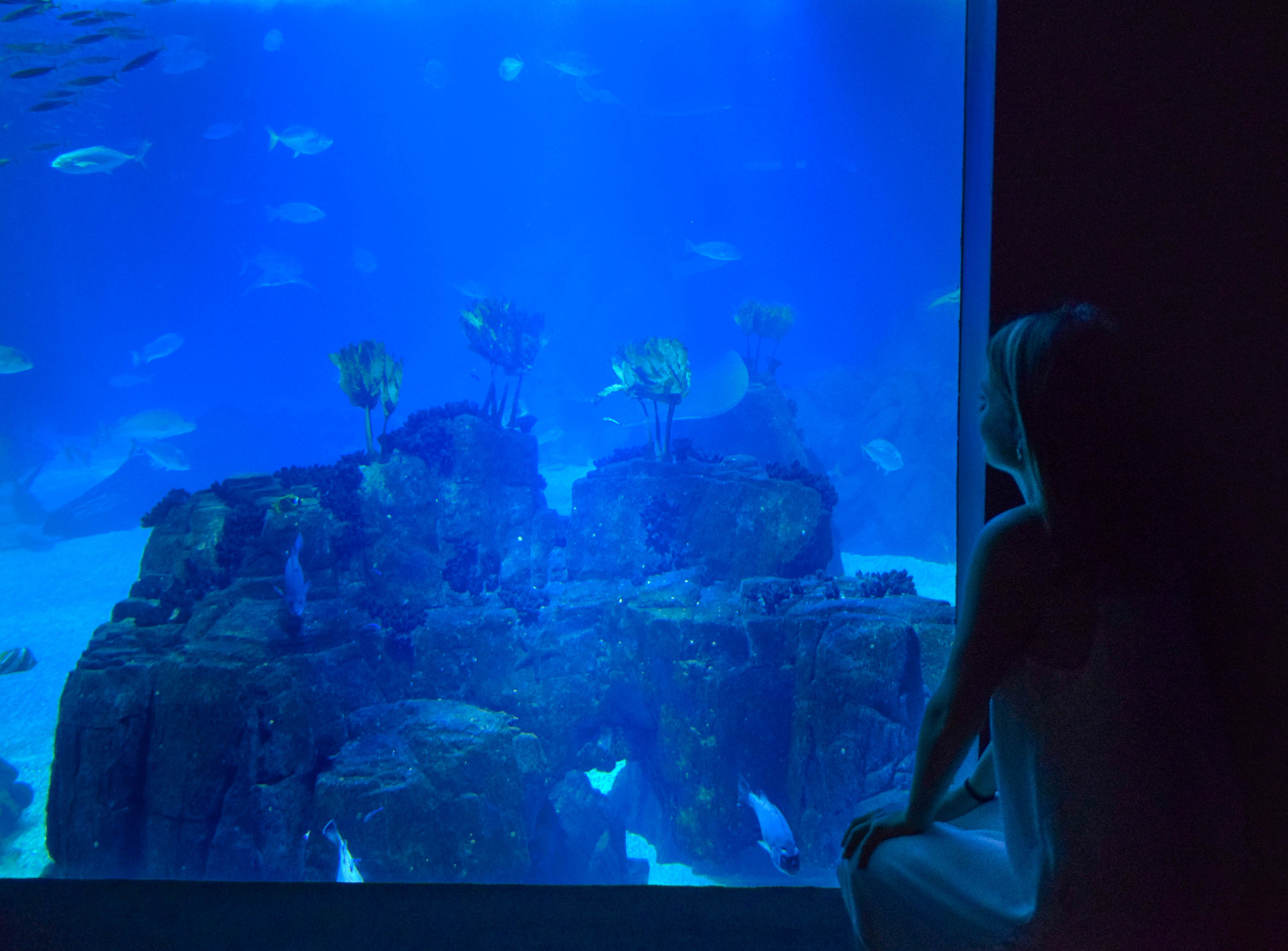
Water Gardens
These gardens next to the Oceanarium are the perfect way to cool down on a hot sunny day. They are beautifully accompanied by cone-shaped fountains in different colors, as well as waterfalls and trees are arranged in a way to create a mini forest. Definitely, a nice place to stop by if you are tired and need a bit of rest.
Museu Nacional do Azulejo
The National Tile Museum is another must-see on your way to the city center. What is really interesting about this museum is that it is set in an old church called Madre de Deus. It is quite a big convent and most of the ornaments are made of massive gold, while the lower side of the walls is covered in blue azulejos.
The museum itself holds a big collection of tiles dating back to the 15thcentury and also of ceramics, faience, and porcelain. The azulejos or the Portuguese type of tile are what differentiates the Portuguese culture from the rest of the European cultures. You can see them almost everywhere in Portugal, from buildings decorated with azulejos to bars and restaurants or even churches.
I was really fascinated by the collection of the museum and that it showed the tiles in all the possible forms and ways they can be used. The price to enter is 5 euros, which is a really good price for what you will see inside.
Day Two
Day two is about exploring the old city of Lisbon and the city center where most of the sights are situated. Make sure to let yourself wander around the Alfama district while exploring the sights. It for sure is one of the most beautiful districts in Lisbon.
The best way to reach the center of the city is by using the green line of the metro and taking off either at Martim Moniz or Rossio metro station. From either of the stations, you can start your journey up to the old Alfama district.
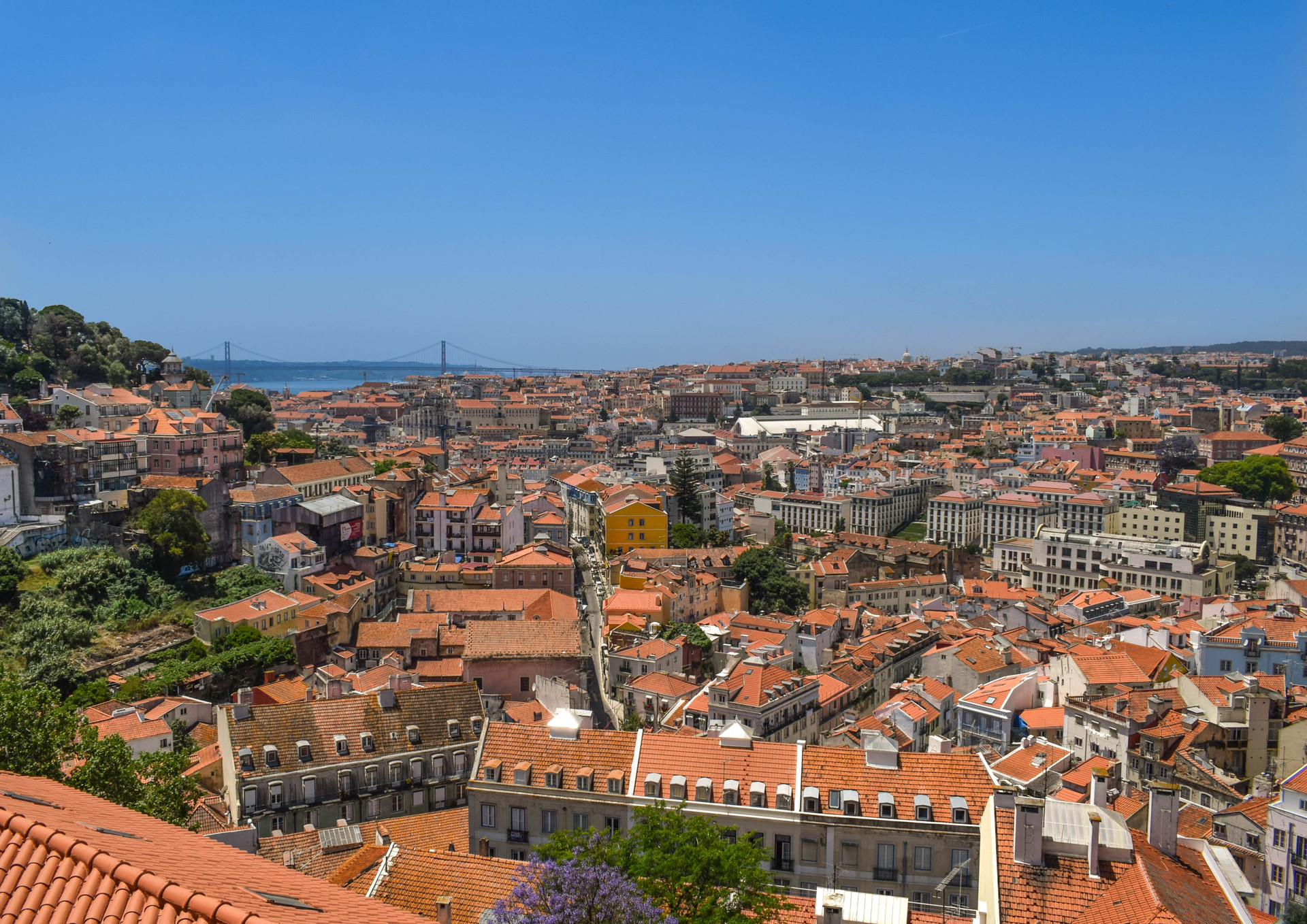
Castelo de São Jorge
The notable ancient castle of São Jorge sits on one of the hilltops in Alfama and overlooks the city. Many say that it is unclear when it was built for sure, but it dates back to the 1st century before Christ, so it is pretty old.
From the castle, you can enjoy some pretty good views over the old town of Lisbon and also the riverside. Furthermore, you can learn a lot about the history of the region and how many tribes have inhabited it and fought with each other.
The price for visiting the castle is 5 euro if you are 25 years old and if older it’s 10 euros.
Sé de Lisboa
The cathedral of Lisbon is one of the most important buildings in the city. It was built over a destroyed mosque and was the seat of the bishop for many years after that. There is an interesting fact about the first bishop who was an English crusader called Gilbert and not a person that was born in the region, as it is supposed to be.
Nowadays, the cathedral is easily recognized in the Alfama district by its Gothic architecture and also for being one of the tallest buildings around. It definitely should be a stop on your walk around the Alfama district.
Rossio Square
You will recognize the Rossio square by its floor in wavy patterns, which creates a bit of illusion that it is moving while you walk. The square is considered to be the place where all of the locals gather to chill and have some fun. It is quite true and you will find lots of people here passing by or just sitting around chatting.
Praça do Comércio
The next square you will visit is absolutely astonishing. Praça do Comércio sits on the waterfront and was the royal Portuguese family’s seat for a long time. The royal family of Portugal was living in their palace exactly where the square is now until the Great earthquake in 1755 that destroyed the palace and they had to move to their other residence in Belem.
In the middle of the square, you will see the statue of King José I of Portugal (“The Reformer”) who was ruling Portugal at that time. The statue was added to the square after the capital was rebuilt.
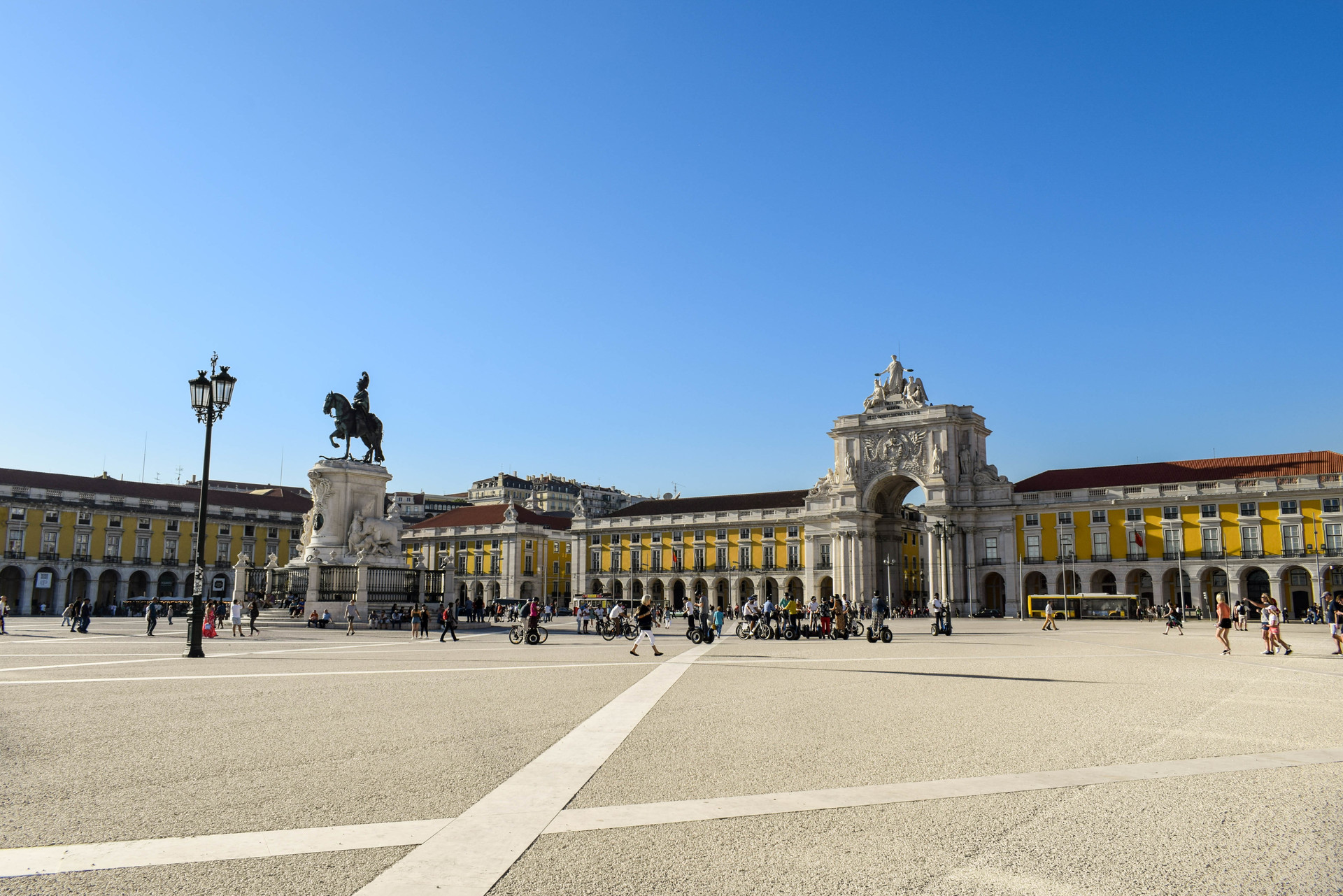
Arco da Rua Augusta
The arch of Rua Augusta street will simply fascinate you with its beautiful ornaments in white and yellow and its size. In addition to that, you can get on top of it and enjoy the view of Comércio Square and the waterfront from above.
To easily get on top just go to the left side of the arch before going to Comércio square. There you will see a tiny entrance from where you can pay the small fee of 3 euros and get to the top with the elevator. Upstairs you will also see the clock’s mechanism, which is one of the oldest clocks in the world.
Day Three
On day three you will be spending your time in the lower part of Lisbon almost near the ocean. I can assure you that you will learn a lot about the Age of the Discoveries and its most notable explorers.
The easiest and fastest way to get to that part of the city is by using the green line of the metro and getting off at Cais do Sodré station. Then, from there you can catch the train to Belem by simply charging your Viva Viagem card with 1.35 euros and validating it before getting on the train. The train ride takes around 10 minutes, so in no time you will be at the tower of Belem where you can start your exploration.
Torre de Belém
That’s the medieval fortress of Lisbon that was guarding the entrance to the city’s harbour. An interesting fact is, that from that exact tower most of the oversee voyages started. The entrance of the tower is 6 euros, and unfortunately, I was not able to enter, as there were lots of people waiting in line there. However, there is a nice park around the tower, which you can visit on your way to the monument of discoveries.
Padrão dos Descobrimentos
The monument of discoveries in Lisbon is famous for depicting the Portuguese overseas expansion, as well as, the most notable explorers of Portugal like Vasco da Gama and Magellan. However, there you can also find a huge map in front of the monument. It shows the whole world and the discoveries made by those famous Portuguese explorers. Unfortunately, many of their discoveries are not theirs anymore, but at least they still have the beautiful Azores islands and Madeira island.
However, it’s quite hard to see the map to its full size, that why I decided to go up the monument. The fee to enter the monument is 3 euros if you are 25 or under. However, if you are older, the price is 6 euros.
I would say that the view is worth it as you can see “25thof April” bridge and the ocean on the other side. In addition to that, you get to see the Jeronimos monastery and its beautiful garden, as well as the map with all the discoveries in its full size. It is a truly breathtaking view!
Mosteiro dos Jerónimos
The monastery is one of the most magnificent monasteries you will ever see. With its one of a kind architecture, it shows perfectly how powerful and wealthy was Portugal in the Age of the Discoveries.
It is built in the typical Gothic style in the 15thcentury by King Manuel I to honour the famous explorer Vasco da Gama and his successful voyage to India. His tomb can be found at the entrance of the monastery, as well as that of Luis de Camões, the writer of The Lusiads, which is the most detailed story of Portugal and its discoveries.
I would advise you to go there as early as possible, to avoid the crowds. The ticket can be bought from the website of the monastery from the ticket office for 10 euros.
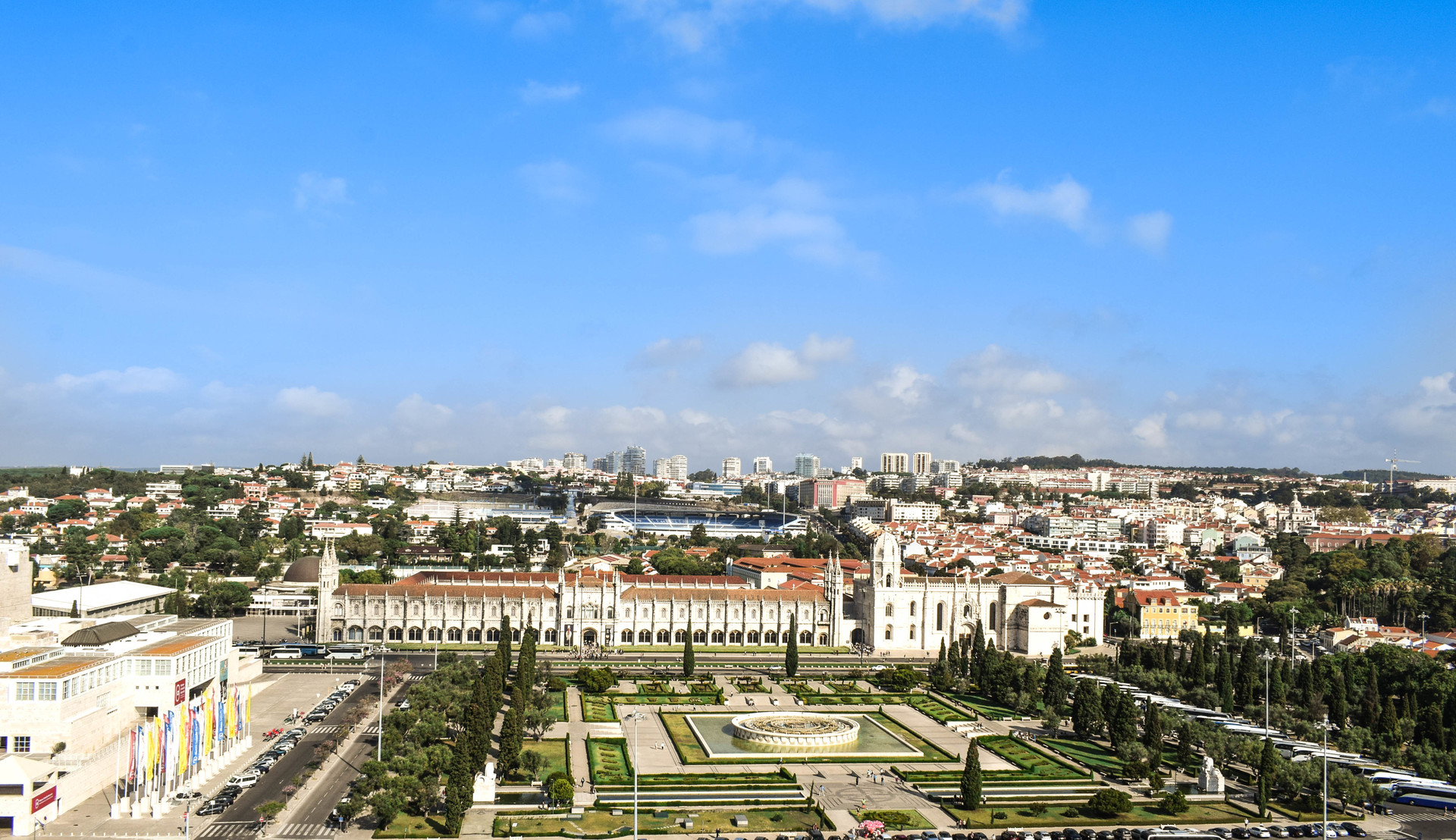
MAAT
Although, Lisbon is a city with pretty old buildings you can find some modern buildings like the Museum of Art, Architecture, and Technology. If you are into arts, architecture or technology you can go inside the museum and observe. However, I went there and climbed on top of it to enjoy the view of the other side of Lisbon.
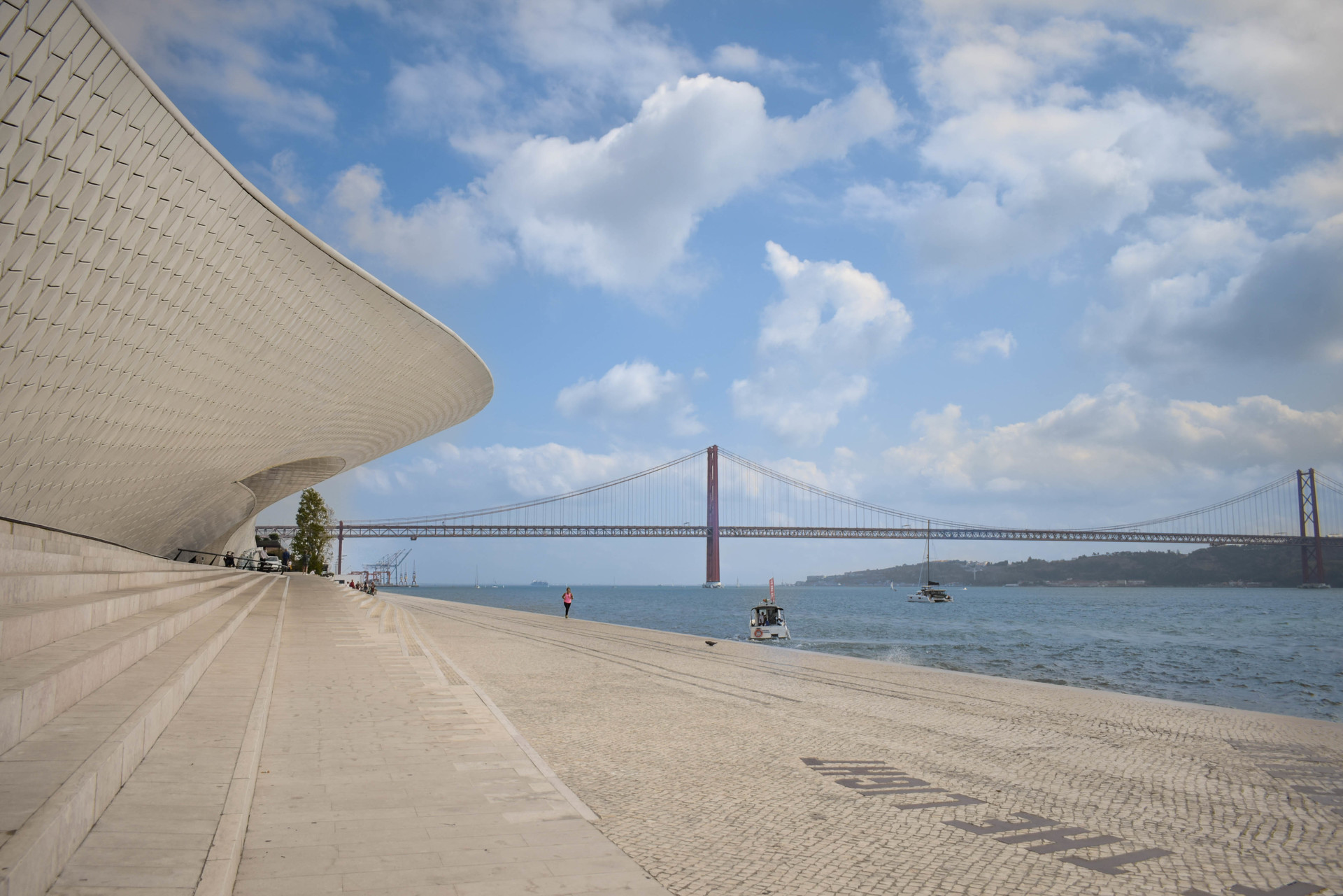
Viewpoints in Lisbon
Miradouro da Senhora do Monte and Miradouro de Santa Luzia are the most famous viewpoints in the old town of Lisbon. However, they can be pretty crowded sometimes and there might not be free places to sit.
Another worth visiting viewpoint is that of the Eduardo VII park from where you can see the beautiful landscape of the city and the river.
The other beautiful viewpoints in the city are mostly situated within the city’s high historic buildings or monuments like the Monument of Discoveries or the Arch of Rua Augusta.
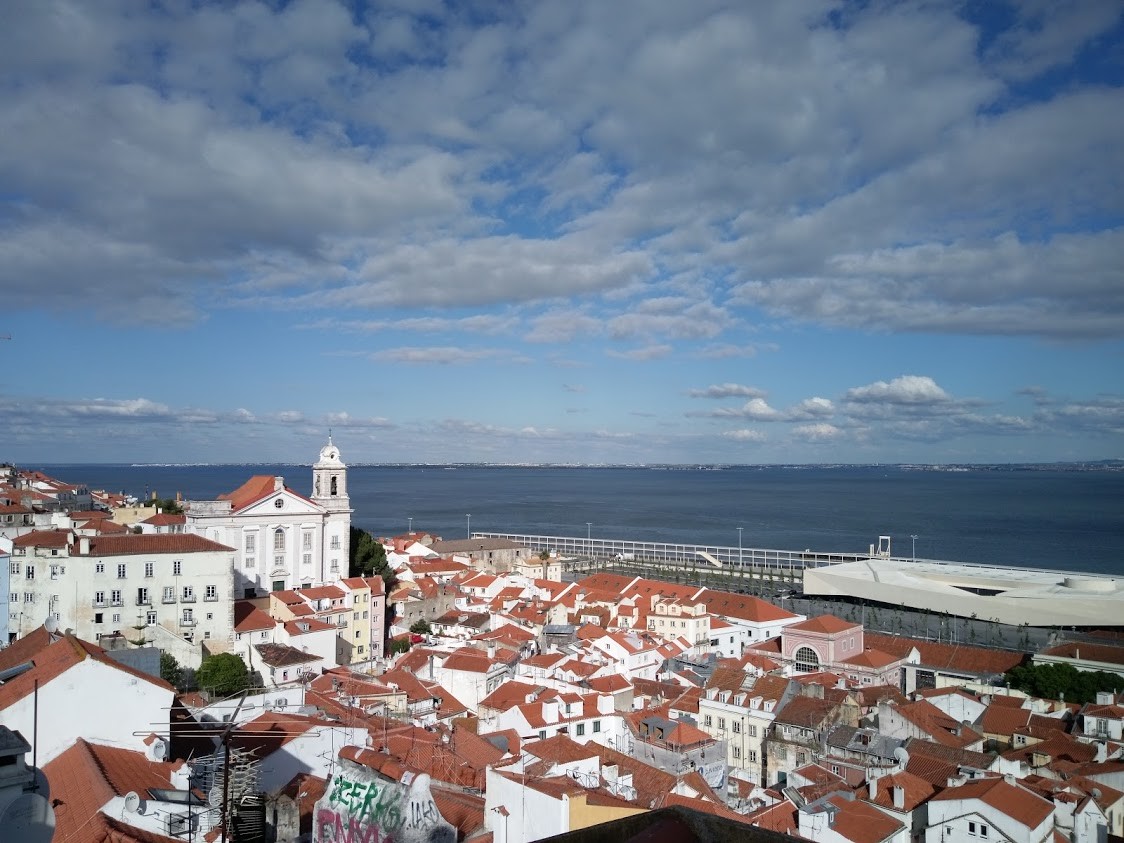
Food in Lisbon
Food in Lisbon is quite diverse and you can find everything to eat from salty to sweetie stuff. The most notable pastry is the Pastel de Nata, which you can find in Pastéis de Belém bakery. This bakery is the first one that started producing the original Pastel de Nata in 1837. Nowadays, you will see lots of people waiting in line to get into the bakery, which is not so pleasant, but the pastries are totally worth it.
One Pastel de Nata here costs 1.05 euros and you can get it fresh out of the oven and spread some cinnamon over it. This is how it’s done the traditional way.
A good restaurant in the heart of Alfama I would suggest is Pateo 13. It’s a traditional Portuguese restaurant offering the finest seafood cooked in various ways. The price of the food varies depending on the dish you choose, but you can get one for less than 10 euros. However, sometimes there is a huge line of people waiting to be seated, especially when there are celebrations. So keep that in mind and go early in the evening to avoid waiting in line.
Another good option for eating out is Restaurante A Gina, which is near the Eduardo VII park. They have excellent traditional options to choose from, but it can be a bit expensive for a student.
I also ate at A Parreirinha do Paraíso and it offers great seafood options for a lot cheaper prices than the restaurants in the city center. I got grilled Bass there for less than 10 euros and it was delicious.
Lisbon weather
Lisbon has pretty good weather compared to other European capitals. With its long hot summers and short rainy winters, it really makes it enjoyable for most of its visitors. I have been in Lisbon in May, June and in October and the weather was pretty good and sunny. However, as I have heard from locals and friends, in the summer it is quite crowded and unpleasantly hot. So, my advice to you is to visit Lisbon in May, June or September, October when the weather is still pretty good and there are fewer crowds.
Celebrations in Lisbon
Lisbon is a city where lots of celebrations are held, but one of the biggest is the Festas Santos Populares, which means the Festival of the Popular Saints. It starts on the 12th of June and finishes on the 13th of June. On these days people celebrate the patron saint of Lisbon – Saint Anthony and also the bank holiday of the capital. The festival ends with a carnival and lots of street dancing till sunrise on the next day.
It’s a huge celebration and you will see all of the people outside on the streets partying and having fun. The district of Alfama and most of Lisbon’s neighbourhoods are decorated with lots of tinsels and colorful streamers.
Being part of this celebration in Lisbon was a truly amazing experience and I had a lot of fun. Also, the carnival was one of the biggest carnivals I have ever seen, almost as big as that one in Rio de Janeiro.

Photo gallery
Content available in other languages
Want to have your own Erasmus blog?
If you are experiencing living abroad, you're an avid traveller or want to promote the city where you live... create your own blog and share your adventures!
I want to create my Erasmus blog! →






















Comments (0 comments)